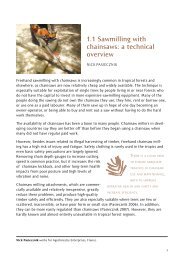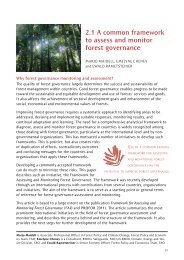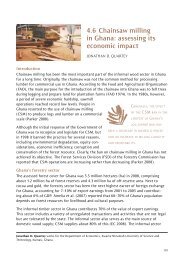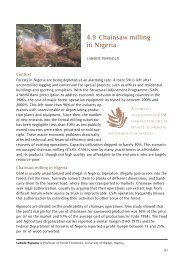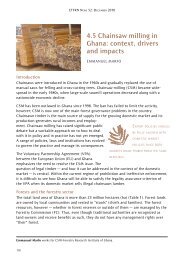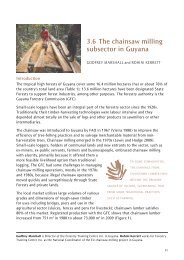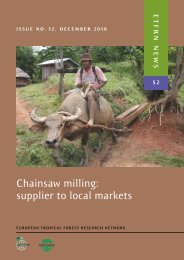Chainsaw milling: supplier to local markets - European Tropical ...
Chainsaw milling: supplier to local markets - European Tropical ...
Chainsaw milling: supplier to local markets - European Tropical ...
Create successful ePaper yourself
Turn your PDF publications into a flip-book with our unique Google optimized e-Paper software.
122<br />
ETFRN NEws 52: DEcEmbER 2010<br />
roundwood equivalent (rwE) in 1996 (Enviro-protect 1997). plouvier et al. (2002)<br />
analyzed several <strong>markets</strong> in Yaoundé and Douala and estimated the national Csm<br />
production at about 1 million m 3 rwE.<br />
although recent estimates are not available for other countries of the region, several<br />
indications show that Csm production is significant. in Gabon, for instance, rural citizens<br />
still use family logging authorizations, which were abolished by the 2001 forest code, <strong>to</strong><br />
harvest and trade timber around their villages. Given the number of people employed by<br />
the forestry sec<strong>to</strong>r as sawyers, fellers and prospec<strong>to</strong>rs, who have thus acquired the necessary<br />
skills, rural Gabon offers a large operational capacity and availability of resources for<br />
the production of informal timber. The law allows small-scale opera<strong>to</strong>rs <strong>to</strong> apply for legal<br />
logging authorizations, but the administration has been very slow <strong>to</strong> implement the granting<br />
of such titles; only in mid-2009 were the first requests reviewed by the administration.<br />
in DrC, forest resources are managed in a socio-economic and political post-conflict<br />
situation. The last decade, characterized by widespread insecurity, has prompted the<br />
vast majority of people <strong>to</strong> turn <strong>to</strong> subsistence and informal activities. The volume of logs<br />
produced by the informal sec<strong>to</strong>r is inherently difficult <strong>to</strong> quantify. nonetheless, it is an<br />
important sec<strong>to</strong>r in DrC, as evidenced by the number of rafts that can be seen on the<br />
rivers, sawnwood planks found in many <strong>markets</strong>, and axe-cut logs in kinshasa. Djiré<br />
(2003) estimated that artisanal loggers produce between 1.5 and 2.4 million m 3 , five <strong>to</strong><br />
eight times the official industrial timber production.<br />
in the republic of Congo, the law allows for special permits for small-scale loggers <strong>to</strong><br />
exploit timber and non-timber forest products. in the case of timber, special permits<br />
allow the harvesting of three trees for domestic purposes and five trees for commercial<br />
uses. The latter is allowed only in areas where people have difficulty obtaining supplies of<br />
industrial scraps. The difficulty of acquiring this permit, especially in rural areas, pushes<br />
many opera<strong>to</strong>rs <strong>to</strong> remain in the informal sec<strong>to</strong>r, which causes the administration <strong>to</strong><br />
establish checkpoints and mobilize patrol teams. The informal timber market in<br />
brazzaville seems <strong>to</strong> have declined considerably after the intensive activity observed in<br />
the early 1990s, mainly due <strong>to</strong> the establishment of the checkpoints and <strong>to</strong> the provision<br />
of large amounts of scrap lumber in brazzaville and pointe noire (ampolo 2005). 2<br />
Methodology<br />
Given the lack of information on Csm in the Congo basin — and on its social, economic<br />
and ecological dynamics — it is imperative <strong>to</strong> conduct systematic studies in order <strong>to</strong><br />
effectively reform the forest sec<strong>to</strong>r. This article summarizes the preliminary results of<br />
ongoing research that started in 2008 in four Central african countries: Cameroon, the<br />
republic of Congo, DrC and Gabon. The project focused on sawn products sold in the<br />
domestic market. These are sourced all over the region using both legally produced timber,<br />
such as scraps from industrial sawmills or small-scale logging titles, and illegally produced<br />
timber, which comprises the vast majority of the chainsaw production.<br />
a three-step approach was adopted in the four countries. First, a sample of outlets<br />
located in all districts of the main cities was moni<strong>to</strong>red on a weekly basis. The wood sold



